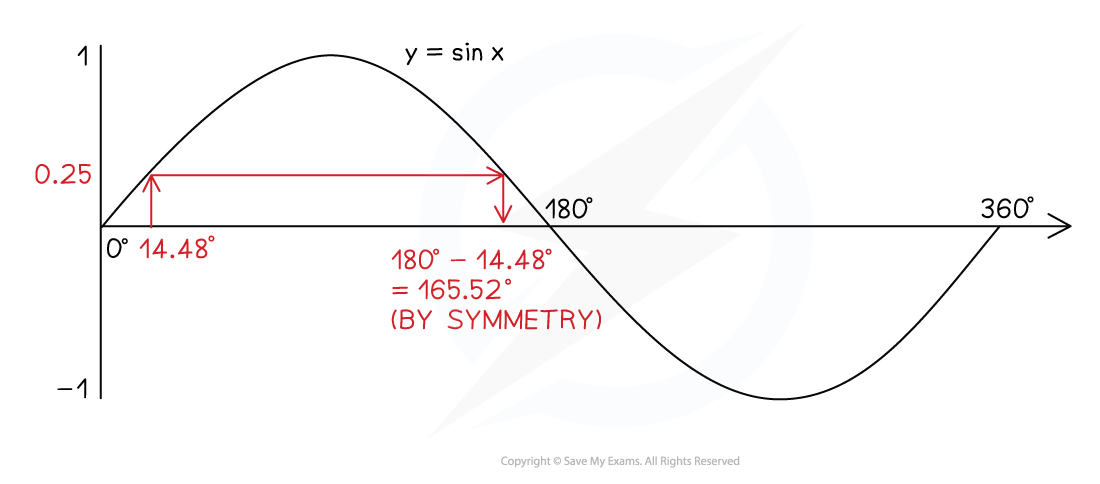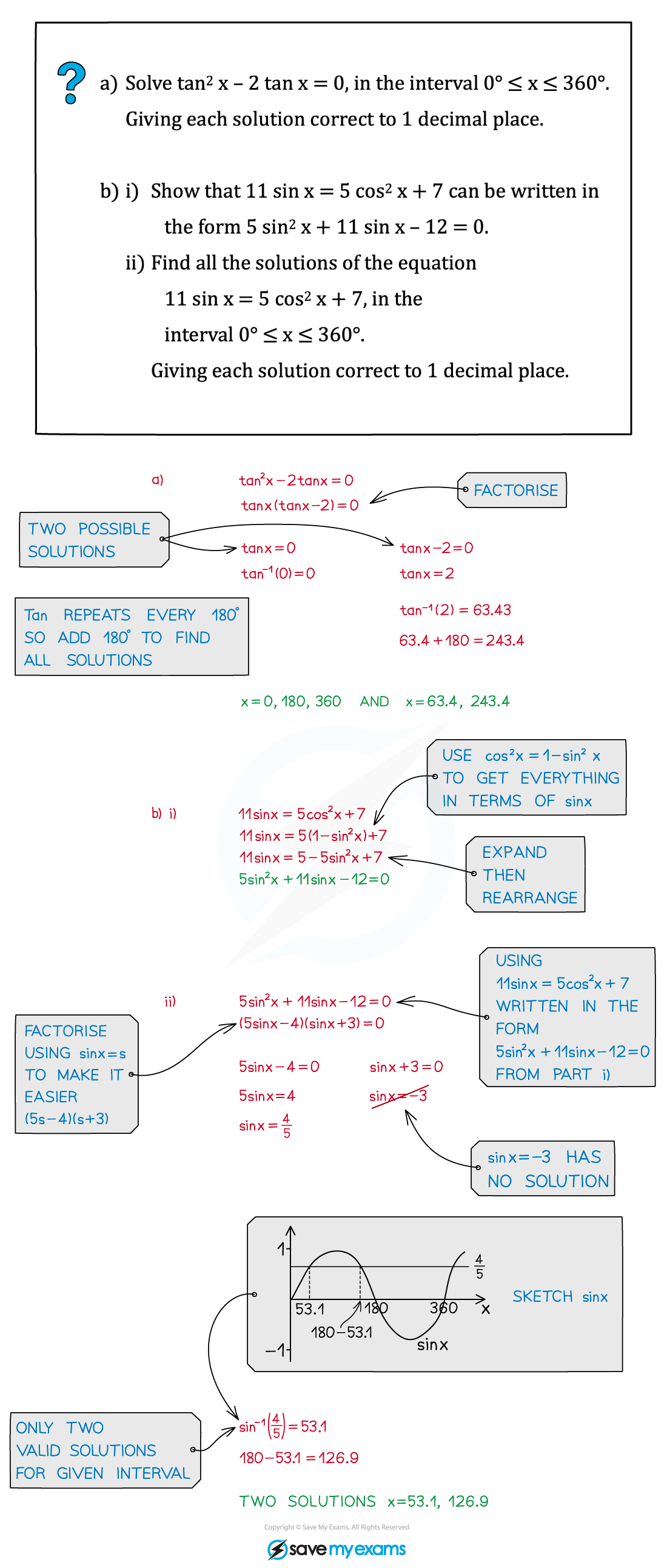Solving Trig Equations (AQA GCSE Further Maths): Revision Note
Exam code: 8365
Solving basic trig equations
What are basic trig equations?
The types of equations dealt with here are those of the form
where
is a constant
(Most) scientific calculators will give you an answer to this type of equation
using inverse sin/cos/tan
e.g.
but trig equations usually have more than one solution
For inverse sin (sin-1) and inverse tan (tan-1)
(most) calculators will give an answer between -90° and 90°
For inverse cos (cos-1)
(most) calculators will give an answer between 0° and 180°
A question may require answers beyond these ranges
Typically, answers between 0° and 360° are required
The properties (in particular, symmetry) of the trig graphs allow us to find all answers to trig equations
How are trigonometric equations of the form sin x = k solved?
The solutions to the equation sin x = 0.5 in the range 0° < x < 360° are x = 30° and x = 150°
If you like, check on a calculator that both sin 30° and sin 150° give 0.5
The first solution comes from your calculator (by taking inverse sin of both sides)
x = sin-1 (0.5) = 30°
The second solution comes from the symmetry of the graph y = sin x between 0° and 360°
Sketch the graph
Draw a vertical line from x = 30° to the curve, then horizontally across to another point on the curve, then vertically back to the x-axis again
By the symmetry of the curve, the new value of x is 180° - 30° = 150°
In general, if x° is an acute angle that solves sin x = k, then 180° - x° is the obtuse angle that solves the same equation
If/when a calculator gives x as a negative value when using inverse sin
extend your graph sketch for negative values of x (i.e. to the left of the y-axis)

How are trigonometric equations of the form cos x = k solved?
The solutions to the equation cos x = 0.5 in the range 0° < x < 360° are x = 60° and x = 300°
If you like, check on a calculator that both cos 60° and cos 300° give 0.5
The first solution comes from your calculator (by taking inverse cos of both sides)
x = cos-1 (0.5) = 60°
The second solution comes from the symmetry of the graph y = cos x between 0° and 360°
Sketch the graph
Draw a vertical line from x = 60° to the curve, then horizontally across to another point on the curve, then vertically back to the x-axis again
By the symmetry of the curve, the new value of x is 360° - 60° = 300°
In general, if x° is an angle that solves cos x = k, then 360° - x° is another angle that solves the same equation
(Most) calculators will not give x as a negative value when using inverse cos

How are trigonometric equations of the form tan x = k solved?
The solutions to the equation tan x = 1 in the range 0° < x < 360° are x = 45° and x = 225°
Check on a calculator that both tan 45° and tan 225° give 1
The first solution comes from your calculator (by taking inverse tan of both sides)
x = tan-1(1) = 45°
The second solution comes from the symmetry of the graph y = tan x between 0° and 360°
Sketch the graph
Draw a vertical line from x = 45° to the curve, then horizontally across to another point on the curve (a different “branch” of tan x), then vertically back to the x-axis again
The new value of x is 45° + 180° = 225° as the next “branch” of tan x is shifted 180° to the right
In general, if x° is an angle that solves tan x = k, then x° + 180° is another angle that solve the same equation
If/when a calculator gives x as a negative value when using inverse tan
extend your graph sketch for negative values of x (i.e. to the left of the y-axis)

Examiner Tips and Tricks
Use a calculator to check your solutions by substituting them into the original equation
e.g. 60° is a correct solution of cos x = 0.5 as cos 60° = 0.5 on a calculator
but 330° is an incorrect solution as cos 330° ≠ 0.5
Worked Example
Solve sin x = 0.25 in the range 0° < x < 360°, giving your answers correct to 1 decimal place
Use a calculator to find the first solution (by taking inverse sin of both sides)
x = sin-1(0.25) = 14.4775… = 14.48° to 2 dp
Sketch the graph of y = sin x and mark on (roughly) where x = 14.48 and y = 0.25 would be
Draw a vertical line up to the curve, then horizontally across to the next point on the curve, then vertically back down to the x-axis

Find this value using the symmetry of the curve (by taking 14.48 away from 180)
180° – 14.48° = 165.52°
Give both answers correct to 1 decimal place
x = 14.5° or x = 165.5°
Solving quadratic trig equations
What is a quadratic trig equation?
A quadratic trig equation will have a 'squared' term involved in it
this will be either sin2x, cos2x or tan2x
there may be terms involving sin x, cos x or tan x as well
and possibly a constant term (i.e. a number)
Quadratic trig equations are very similar to normal quadratic equations
but the 'x' is replaced by 'sin x' (or 'cos x' or 'tan x')
Recall from the work on trig identities that sin2x means the same as (sin x)2
and likewise for cos/tan
How do I solve quadratic trig equations?
When first practising solving quadratic trig equations it may be helpful to replace sin x, cos x or tan x by a letter, y say
e.g. for the quadratic trig equation
replacing "tan x" with "y" gives
if you know what "hidden quadratics" are, this is the same process
Solve the quadratic equation as you normally would
the equation may need rearranging so it is in quadratic form
e.g.
solving the equation may involve factorising, completing the square or the quadratic formula
The answer(s) to the quadratic equation will not be the values for x (they are the values of y)
i.e. they are the values of sin x, cos x or tan x
y = tan x in our example
Replace y with its trig function to form two basic trig equations to solve to find the values of x
e.g.
and
Using inverse tan, the values for x in the range
are
(1 d.p.) and
Sketching the graph of
between 0° and 360° shows the other two solutions
and
In harder problems, one of the basic trig equations may have no possible solutions
e.g.
The graph y = cos x is always between -1 to 1 on the y-axis, so this trig equation has no solutions
Worked Example
Solve the equation for
, giving your answers for x as exact values.
Let y = sin x and rewrite the equation in y
This equation can be solved by rearranging to but you must remember
)
A neater way to get two solutions is to use the difference of two squares
Solve the factorised equation (by setting each bracket equal to zero)
or
Replace the y with sin x
or
Write out the "first half" of this problem and solve it
where
Use a calculator (or your knowledge of exact trig values) to find inverse sin
Use a sketch of to find the other solution (by symmetry

Write out the two solutions so far
x = 30° or x = 150°
Now write out the "second half" of this problem and solve it
where
From extending the sketch above in the negative x-axis, or using , the first negative solution is
x = -30°
But this is not in the range 0° to 360°
Adding 30° to 180° and subtracting 30° from 360° would give the correct values
x = 180° + 30° = 210° or x = 360° - 30° = 330°
Combine these two solutions with the two found previously
It is good practice to write final solutions out in numerical order
x = 30, 150, 210, 330
Solving trig equations with identities
How do I use trig identities to help solve trig equations?
In general, trig equations are easiest to solve when they involve one out of sin x, cos x or tan x only
For some equations involving different trig functions, you can often rewrite them back in terms of one only
To do this, use one (or both) of the identities
or
The majority of questions will involve the second identity as this is frequently used with quadratic trig equations
It will be used in one of its rearranged forms
or
which will replace
terms (with cos2 ...) and
terms (with sin2 ...) respectively
choose whichever suits the question
e.g. The equation
can be rewritten as
which involves sin x terms only and so is easier to solve (after some rearranging)
The
identity is used less frequently and would normally appear in reverse
e.g. The equations
or
or
etc can be rewritten as
this can be solved using a calculator and the graph of
Examiner Tips and Tricks
Write out both identities for any trig equation questions in case they help
Sketch the appropriate graph
y = sin x, y = cos x or y = tan x
use the graph to ensure you find ALL solutions within the given interval
this is particularly important when a calculator gives an initial negative answer
Worked Example

Worked Example
Solve the equation for
.
Add 6cos x to both sides to bring the cos x terms together
Divide both sides by 9
By considering the identity , divide both sides by cos x
Cancel the left-hand side (this does not cancel to give zero)
Use the identity to rewrite the right-hand side as tan x
The problem is now to solve the following
where
Use , or your knowledge of exact trig values, to find the first x solution
x = 45
Sketch the graph of y = tan x to find the other solution

Write the two solutions in numerical order
x = 45 or x = 225

Unlock more, it's free!
Did this page help you?